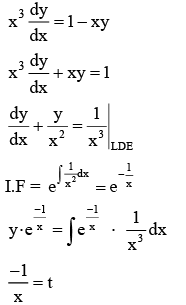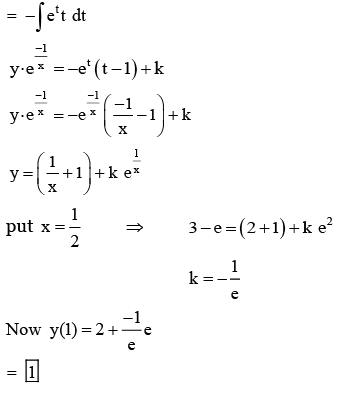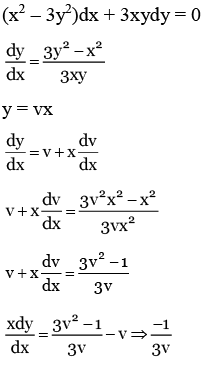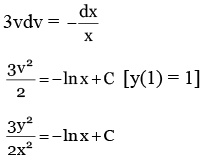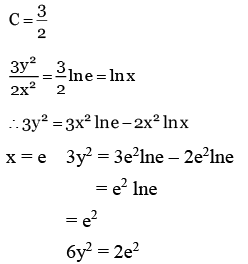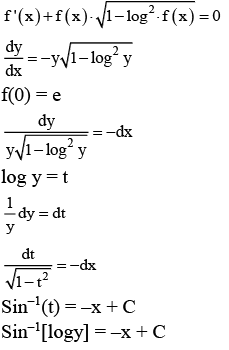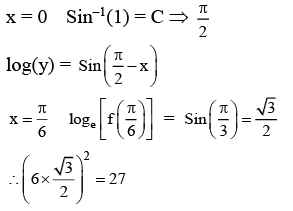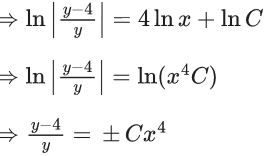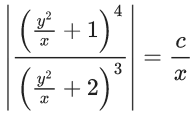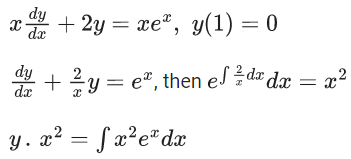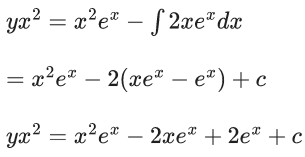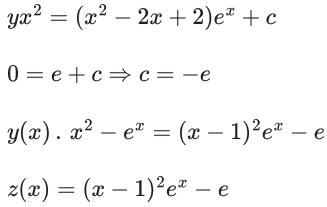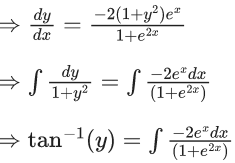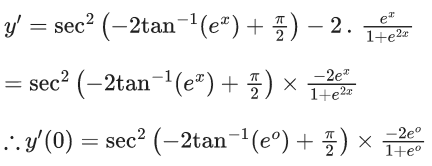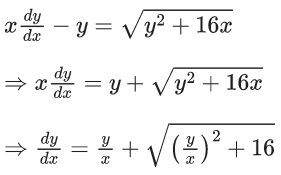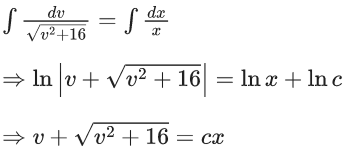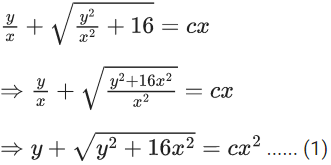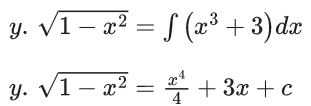Q.1. Let y = y(x) be the solution of the differential equation x3 dy + (xy − 1)dx = 0, x > 0, y (1/2) = 3 - e.
Then y(1) is equal to (JEE Main 2023)
(a) 1
(b) e
(c) 3
(d) 2 – e
Ans. a
x3 dy + (xy – 1) dx = 0
Q.2. Let y = y(x) be the solution of the differential equation (x2 − 3y2)dx + 3xydy = 0, y(1) = 1.
Then 6y2(e) is equal to (JEE Main 2023)
(a) 2e2
(b) 3e2
(c) e2
(d) 
Ans. a
Q.3. Let f be a differentiable function defined on  such that f(x) > 0 and
such that f(x) > 0 and is equal to (JEE Main 2023)
is equal to (JEE Main 2023)
Ans. 27
Q.4. For  let the function y(x) be the solution of the differential equation
let the function y(x) be the solution of the differential equation
Then, which of the following statements is/are TRUE ? (JEE Advanced 2022)
(a) y(x) is an increasing function
(b) y(x) is a decreasing function
(c) There exists a real number β such that the line y=β intersects the curve y=y(x) at infinitely many points
(d) y(x) is a periodic function
Ans. c
Q.5. If y(x) is the solution of the differential equation for xdy − (y2 − 4y)dx = 0 for x > 0, y(1) = 2, and the slope of the curve y = y(x) is never zero, then the value of 10y(√2) is (JEE Advanced 2022)
Ans. 8
xdy = (y2 - 4y)dx = 0
⇒ xdy = (y2 - 4y)dx
Integrating both side, we get
Given, y(1) = 2
⇒ λ = -1
⇒ y − 4 = −4y
⇒ 5y = 4
⇒ y = 45
∴ 10y(√2) = 10 x (4/5) = 8
Q.6. Let y = y(x) be the solution curve of the differential equation  which passes through the point (0, 1). Then y(1) is equal to : (JEE Main 2022)
which passes through the point (0, 1). Then y(1) is equal to : (JEE Main 2022)
(a) 1/2
(b) 3/2
(c) 5/2
(d) 7/2
Ans. b
Integrating factor I.F.
Let
A = 2, B = 1, C = -1
I.F. = e(2In|x+1) + In|x+2| - In|x+3|)
Solution of differential equation
Curve passes through (0, 1)
So,
Q.7. If the solution curve of the differential equation  passes through the points (2, 1) and (k+1, 2), k > 0, then (JEE Main 2022)
passes through the points (2, 1) and (k+1, 2), k > 0, then (JEE Main 2022)
(a) 
(b) 
(c) 
(d) 
Ans. a
Let x − 1 = X, y − 1 = Y
Curve passes through (2,1)
0 − 0 = 0 + c ⇒ c = 0
If (k + 1, 2) also satisfies the curve
Q.8. Let the solution curve y = y(x) of the differential equation  pass through the point
pass through the point  Then,
Then,  is equal to : (JEE Main 2022)
is equal to : (JEE Main 2022)
(a) π/4
(b) 3π/4
(c) π/2
(d) 3π/2
Ans. b
∴ Solution
⇒ exy(x) = tan−1(ex) + C
∵ It passes through
= 3π/4
Q.9. The differential equation of the family of circles passing through the points (0, 2) and (0, −2) is : (JEE Main 2022)
(a) 
(b) 
(c) 
(d) 
Ans. a
Family of circles passing through the points (0, 2) and (0, −2)
x2 + (y − 2)(y + 2) + λx = 0, λ ∈ R
x2 + y2 + λx − 4 = 0 ...... (1)
Differentiate w.r.t x
Using (1) and (2), eliminate λ
Q.10. Let y = y(x) be the solution curve of the differential equation  passing through the point
passing through the point  Then √7y(8) is equal to : (JEE Main 2022)
Then √7y(8) is equal to : (JEE Main 2022)
(a) 11 + 6loge3
(b) 19
(c) 12 − 2loge3
(d) 19 − 6loge3
Ans. d
Integrating factor I.F.
Solution of differential equation
Curve passes through
√7 .y(8) = 19 - 6 In 3
Q.11. The minimum value of the twice differentiable function  is : (JEE Main 2022)
is : (JEE Main 2022)
(a) 
(b) 
(c) 
(d) 
Ans. a
Differentiate on both side
e−xf′(x) + (−f(x)e−x) = e−xf′(x) − 2x + 1
f(x) = ex(2x − 1)
f′(x) = ex(2) + ex(2x − 1)
= ex(2x + 1)
x = −(1/2)
f″(x) = ex(2) + (2x+1)ex
= ex(2x + 3)
For x = -(1/2) f"(x) > 0
⇒ Maxima
Q.12. If y = y(x), x ∈ (0, π/2) be the solution curve of the differential equation (sin22x)(dy/dx) + (8sin22x + 2sin4x)y = 2e−4x(2sin2x + cos2x), with y(π/4) = e−π, then y(π/6) is equal to : (JEE Main 2022)
(a) 
(b) 
(c) 
(d) 
Ans. a
Integrating factor
(I.F.) = e∫(8 + 4cot2x)dx
= e8x+2lnsin2x
Solution of differential equation
y.e8x + 2lnsin2x
Q.13. Let the solution curve of the differential equation  intersect the line x = 1 at y = 0 and the line x = 2 at y = α. Then the value of α is : (JEE Main 2022)
intersect the line x = 1 at y = 0 and the line x = 2 at y = α. Then the value of α is : (JEE Main 2022)
(a) 1/2
(b) 3/2
(c) -(3/2)
(d) 5/2
Ans. b
at x = 1, y = 0
⇒ C = 0
At x = 2,
OR y = 3/2
Q.14. Let y = y1(x) and y = y2(x) be two distinct solutions of the differential equation dy/dx = x + y, with y1(0) = 0 and y2(0) = 1 respectively. Then, the number of points of intersection of y = y1(x) and y = y2(x) is (JEE Main 2022)
(a) 0
(b) 1
(c) 2
(d) 3
Ans. a
dy/dx = x + y
Let x + y = t
ln|t + 1| = x + C′
|t + 1| = Cex
|x + y + 1| = Cex
For y1(x), y1(0) = 0 ⇒ C = 1
For y2(x), y2(0) = 1 ⇒ C = 2
y1(x) is given by |x + y + 1| = ex
y2(x) is given by |x + y + 1| = 2ex
At point of intersection
ex = 2ex
No solution
So, there is no point of intersection of y1(x) and y2(x).
Q.15. Let the solution curve y=f(x) of the differential equation  pass through the origin. Then
pass through the origin. Then  is equal to (JEE Main 2022)
is equal to (JEE Main 2022)
(a) 
(b) 
(c) 
(d) 
Ans. b
which is first order linear differential equation.
Integrating factor
∵ x ∈ (−1, 1)
Solution of differential equation
Curve is passing through origin, c = 0
put x = sinθ
dx = cosθdθ
Q.16. If (dy/dx) + 2y tanx = sinx, 0 < x < (π/2) and y(π/3) = 0, then the maximum value of y(x) is : (JEE Main 2022)
(a) 1/8
(b) 3/4
(c) 1/4
(d) 3/8
Ans. a
(dy/dx) + 2y tanx = sinx
which is a first order linear differential equation.
Integrating factor (I. F.) = e∫2tanxdx
= e2ln|secx| = sec2x
Solution of differential equation can be written as
y . sec2x = ∫sinx . sec2x dx = ∫secx . tan x dx
y sec2x = secx + C
ymax = 1/8
Q.17. The general solution of the differential equation (x − y2)dx + y(5x + y2)dy = 0 is : (JEE Main 2022)
(a) (y2+x)4 = C|(y2+2x)3|
(b) (y2+2x)4 = C|(y2+x)3|
(c) |(y2+x)3| = C(2y2+x)4
(d) |(y2+2x)3| = C(2y2+x)4
Ans. a
(x−y2)dx + y(5x+y2)dy = 0
Now substitute, t = vx|(y2 + x)4| = C|(y2 + 2x)3|
Q.18. If x = x(y) is the solution of the differential equation ((y)(dx/dy)) = 2x + y3(y + 1)ey, x(1) = 0; then x(e) is equal to : (JEE Main 2022)
(a) e3(ee - 1)
(b) ee(e3- 1)
(c) e2(ee + 1)
(d) ee(e2 - 1)
Ans. a
Solution is given by
⇒ x = y2(yey + c) at, y=1,x=0
⇒ 0 = 1(1⋅e1 + c) ⇒ c = −e at y = e,
x = e2(e.ee − e)
Q.19. If the solution curve y = y(x) of the differential equation y2dx + (x2 − xy + y2)dy = 0, which passes through the point (1, 1) and intersects the line y = √3x at the point (α, √3α), then value of loge(√3α) is equal to : (JEE Main 2022)
(a) π/3
(b) π/2
(c) π/12
(d) π/6
Ans. c
Put y = vx we get
As it passes through (1, 1)
c = π/4
Put y = √3x we get
Q.20. Let y = y(x) be the solution of the differential equation (x + 1)y′ − y = e3x(x + 1)2, with y(0) = (1/3). Then, the point x = −(4/3) for the curve y = y(x) is : (JEE Main 2022)
(a) not a critical point
(b) a point of local minima
(c) a point of local maxima
(d) a point of inflection
Ans. b
∵ y(0) = (1/3)
∴ c = 0
⇒ x = (−4)/3 is point of local minima.
Q.21. If y = y(x) is the solution of the differential equation 2x2(dy/dx) - 2xy + 3y2 = 0 such that y(e) = e/3, then y(1) is equal to (JEE Main 2022)
(a) 1/3
(b) 2/3
(c) 3/2
(d) 3
Ans. b
y = 2/3
Q.22. Let g : (0, ∞) → R be a differentiable function such that  for all x > 0, where c is an arbitrary constant. Then : (JEE Main 2022)
for all x > 0, where c is an arbitrary constant. Then : (JEE Main 2022)
(a) g is decreasing in (0,π4)
(b) g' is increasing in (0,π4)
(c) g + g' is increasing in (0,π2)
(d) g − g' is increasing in (0,π2)
Ans. d
On differentiating both sides w.r.t. x, we get
g(x) is increasing in (0, π/4)
g"(x) = −sinx − cosx < 0
⇒ g′(x) is decreasing function
let h(x) = g(x) + g′(x) = 2cosx + C
⇒ h′(x) = g′(x) + g′′(x) = −2sinx < 0
⇒ h is decreasing
let ϕ(x) = g(x) − g′(x) = 2sinx + C
⇒ ϕ′(x) = g′(x) − g′′(x) = 2cosx > 0
⇒ ϕ is increasing
Hence option D is correct.
Q.23. If the solution of the differential equation (dy/dx) + ex(x2 − 2)y = (x2−2x)(x2−2)e2x satisfies y(0) = 0, then the value of y(2) is ______. (JEE Main 2022)
(a) -1
(b) 1
(c) 0
(d) e
Ans. c
∴ Solution of the differential equation is
Let (x2 − 2x)ex = t
∴ (x2 − 2)exdx = dt
∴ y(0) = 0
∴ c = 1
∴ y(2) = −1 + 1 = 0
Q.24. If y = y(x) is the solution of the differential equation x(dy/dx) +2y = xex, y(1) = 0 then the local maximum value of the function z(x) = x2y(x) − ex, x ∈ R is : (JEE Main 2022)
(a) 1 - e
(b) 0
(c) 1/2
(d) (4/e) - e
Ans. d
For local maximum z'(x) = 0
∴ 2(x−1)ex + (x−1)2ex = 0
∴ x = −1
And local maximum value = z(−1)
= (4/e) − e
Q.25. If  x, y > 0, y(1) = 1, then y(2) is equal to: (JEE Main 2022)
x, y > 0, y(1) = 1, then y(2) is equal to: (JEE Main 2022)
(a) 2 + log23
(b) 2 + log32
(c) 2 - log32
(d) 2 - log23
Ans. d
= |(2y−1)(2x−1)| = c
∵ y(1) = 1
∴ c = 1
= |(2y−1)(2x−1)| = 1
For x = 2
|(2y−1)3| = 1
2y−1 = (1/3) ⇒ 2y = (4/3)
Taking log to base 2.
∴ y = 2 − log23
Q.26. If the solution curve of the differential equation ((tan−1y)−x)dy = (1+y2)dx passes through the point (1, 0), then the abscissa of the point on the curve whose ordinate is tan(1), is (JEE Main 2022)
(a) 2e
(b) 2/e
(c) 2
(d) 1/e
Ans. b
∴ Solution
∵ It passes through (1, 0) ⇒ c = 2
Now put y = tan1, then
ex = e−e + 2
⇒ x = 2e
Q.27. Let y = y(x) be the solution of the differential equation x(1−x2)(dy/dx) + (3x2y−y−4x3) = 0, x > 1, with y(2) = −2. Then y(3) is equal to (JEE Main 2022)
(a) -18
(b) -12
(c) -6
(d) -3
Ans. a
Solution of D.E. can be given by
at x = 2, y = −2
Q.28. Let the solution curve y = y(x) of the differential equation  pass through the points (1, 0) and (2α, α), α > 0. Then α is equal to (JEE Main 2022)
pass through the points (1, 0) and (2α, α), α > 0. Then α is equal to (JEE Main 2022)
(a) 
(b) 
(c) 
(d) 
Ans. a
Putting y = tx
at x = 1, y = 0
So, 0 + e0 = 0 + C ⇒ C = 1
at (2α, α)
sin−1(y/x)+ey/x = lnx+1
⇒ π/6 + e(1/2)−1 = ln(2α)
Q.29. Let x = x(y) be the solution of the differential equation  such that x(1) = 0. Then, x(e) is equal to : (JEE Main 2022)
such that x(1) = 0. Then, x(e) is equal to : (JEE Main 2022)
(a) eloge(2)
(b) -eloge(2)
(c) e2loge(2)
(d) -e2loge(2)
Ans. d
Given differential equation
Now, using x(1) = 0, c = 2
So, for x(e), Put y = e in (i)
Q.30. If y = y(x) is the solution of the differential equation  and y (0) = 0, then
and y (0) = 0, then  is equal to (JEE Main 2022)
is equal to (JEE Main 2022)
(a) 2
(b) -2
(c) -4
(d) -1
Ans. c
Given,
Now,
Let ex = t
⇒ exdx = dt
⇒ tan−1(y)= −2tan−1(t) + C
⇒ tan−1(y)= −2tan−1(ex) + C [Putting value of t]
Given, y(0) = 0 means when x = 0 the y = 0
∴ tan−1(0) = −2tan−1(eo) + C
⇒ 0 = −2 × (π/4) + C
⇒ C = (π/2)
∴ tan−1(y) = 2tan−1(ex) + π/2
⇒ y = tan(−2tan−1(ex) + π/2)
Differentiating both sides, we get
= sec2(0)x − 1
= 1 × 1
= −1
And
Q.31. Let the solution curve of the differential equation  Then y(2) is equal to: (JEE Main 2022)
Then y(2) is equal to: (JEE Main 2022)
(a) 15
(b) 11
(c) 13
(d) 17
Ans. a
Given,
This is a homogenous different equation.
Let (y/x) = v
⇒ y = vx
Integrating both sides, we get
Now putting, v = (y/x), we get
Given, y(1) = 3
∴ When x = 1 then y = 3.
Putting in equation (1) we get,
⇒ c = 8
∴ Solution of equation,
Now, y(2) means when x = 2 then y = ?
⇒ y = 15
Q.32. Suppose y = y(x) be the solution curve to the differential equation (dy/dx) − y = 2 − e−x such that  is finite. If a and b are respectively the x - and y-intercepts of the tangent to the curve at x = 0, then the value of a − 4b is equal to ____. (JEE Main 2022)
is finite. If a and b are respectively the x - and y-intercepts of the tangent to the curve at x = 0, then the value of a − 4b is equal to ____. (JEE Main 2022)
Ans. 3
IF = e−x⇒ y = −2 + e−x + Cex
is finite
so C = 0y = −2 + e−x
Equation of tangenty + 1 = −1(x − 0)
or y + x = −1
So a = −1, b = −1
⇒ a − 4b = 3
Q.33. Let f be a twice differentiable function on  and
and  then (2a + 1)5a2 is equal to _____. (JEE Main 2022)
then (2a + 1)5a2 is equal to _____. (JEE Main 2022)
Ans. 8
Q.34. Let y = y(x) be the solution of the differential equation  If for some
If for some  then n is equal to ____. (JEE Main 2022)
then n is equal to ____. (JEE Main 2022)
Ans. 3
Put y = vx
⇒ C = ln2
∴ for y(2)
⇒ [y(2)] = 2⇒ n = 3
Q.35. Let  Let y = y(x), x ∈ S, be the solution curve of the differential equation
Let y = y(x), x ∈ S, be the solution curve of the differential equation  If the sum of abscissas of all the points of intersection of the curve y = y(x) with the curve
If the sum of abscissas of all the points of intersection of the curve y = y(x) with the curve  is kπ/12, then k is equal to ______. (JEE Main 2022)
is kπ/12, then k is equal to ______. (JEE Main 2022)
Ans. 42
sinx = 0 gives x = π only.
Sum of all solutions
Hence, k = 42.
Q.36. Let the solution curve y = y(x) of the differential equation (4+x2)dy − 2x(x2 + 3y + 4)dx = 0 pass through the origin. Then y(2) is equal to _____. (JEE Main 2022)
Ans. 12
(4 + x2)dy - 2x(x2 + 3y + 4)dx = 0
When x = 0, y = 0 gives c = 1/32,
So, for x = 2, y = 12
Q.37. Let y = y(x) be the solution of the differential equation 
 then k−1 is equal to _____. (JEE Main 2022)
then k−1 is equal to _____. (JEE Main 2022)
Ans. 320
Solution is
∴ = k-1 = 320.
Q.38. Let y = y(x), x > 1, be the solution of the differential equation  If
If  then the value of α + β is equal to _____. (JEE Main 2022)
then the value of α + β is equal to _____. (JEE Main 2022)
Ans. 14
Q.39. Let y = y(x) be the solution of the differential equation  with
with  then the value of 3α2 is equal to ____. (JEE Main 2022)
then the value of 3α2 is equal to ____. (JEE Main 2022)
Ans. 2
Q.40. If y = y(x) is the solution curve of the differential equation  and y(1) = 1, then y(1/2) is equal to : (JEE Main 2021)
and y(1) = 1, then y(1/2) is equal to : (JEE Main 2021)
(a) 
(b) 
(c) 3 + e
(d) 3 - e
Ans. d
y(1/2) = 3 - e
Q.41. Let f : R → R be a differentiable function with f(0) = 0. If y = f(x) satisfies the differential equation (dy/dx) = (2 + 5y)(5y − 2), then the value of  is ____. (JEE Advanced 2021)
is ____. (JEE Advanced 2021)
Ans. 0.4
We have,
dy/dx = (2 + 5y)(5y - 2)
On integrating both sides, we get
when x = 0 ⇒ y = 0, then A = 1
Q.42. If  x > 0, ϕ > 0, and y(1) = −1, then
x > 0, ϕ > 0, and y(1) = −1, then  is equal to : (JEE Main 2021)
is equal to : (JEE Main 2021)
(a) 4 ϕ (2)
(b) 4 ϕ (1)
(c) 2 ϕ (1)
(d) ϕ (1)
Ans. b
Let, y = tx
Let φ(t2) = p
∴ φ′(t2)2tdt = dp
Q.43. If  then for y = 1, the value of x lies in the interval : (JEE Main 2021)
then for y = 1, the value of x lies in the interval : (JEE Main 2021)
(a) (1, 2)
(b) ((1/2), 1]
(c) (2, 3)
(d) (0, (1/2)]
Ans. a
⇒ ln|y + 2y|= x + c
x = 0; y = 0 ⇒ c = 0
⇒ x = ln|y + 2y|
⇒ at y = 1, x = ln3
∵ 3 ∈ (e, e2) ⇒ x ∈ (1,2)
Q.44. If  then y(1) is equal to : (JEE Main 2021)
then y(1) is equal to : (JEE Main 2021)
(a) log2(2 + e)
(b) log2(1 + e)
(c) log2(2e)
(d) log2(1 + e2)
Ans. b
C = −log2e
⇒ log2(2y − 1) = (2x − 1)log2e
put x = 1, log2(2y − 1) = log2e
2y = e + 1
y = log2(e + 1) Ans.
Q.45. If the solution curve of the differential equation (2x − 10y3)dy + ydx = 0, passes through the points (0, 1) and (2, β), then β is a root of the equation : (JEE Main 2021)
(a) y5 − 2y − 2 = 0
(b) 2y5 − 2y − 1 = 0
(c) 2y5 − y2 − 2 = 0
(d) y5 − y2 − 1 = 0
Ans. d
(2x − 10y3)dy + ydx = 0
Solution of D.E. is
It passes through (0, 1) → 0 = 2 + C ⇒ C = −2
∴ Curve is xy2 = 2y5 − 2
Now, it passes through (2, β)
2β2 = 2β5 − 2 ⇒ β5 − β2 − 1 = 0
∴ β is root of an equation y5 − y2 − 1 = 0
Q.46. A differential equation representing the family of parabolas with axis parallel to y-axis and whose length of latus rectum is the distance of the point (2, −3) from the line 3x + 4y = 5, is given by : (JEE Main 2021)
(a) 
(b) 
(c) 
(d) 
Ans. d
Length of latus rectum
(x−h)2 = (11/5)(y−k)
differentiate w.r.t. 'x' :-
again differentiate
Q.47. Let us consider a curve, y = f(x) passing through the point (−2, 2) and the slope of the tangent to the curve at any point (x, f(x)) is given by f(x) + xf'(x) = x2. Then : (JEE Main 2021)
(a) x2 + 2xf(x) − 12 = 0
(b) x3 + xf(x) + 12 = 0
(c) x3 − 3xf(x) − 4 = 0
(d) x2 + 2xf(x) + 4 = 0
Ans. c
Solution of DE
Passes through (−2, 2), so
−12 = − 8 + c ⇒ c = − 4
∴ 3xy = x3 − 4
i.e. 3x . f(x) = x3 − 4
Q.48. Let y = y(x) be the solution of the differential equation (dy/dx) = 2(y + 2sinx−5)x − 2cosx such that y(0) = 7. Then y(π) is equal to : (JEE Main 2021)
(a) 
(b) 
(c) 
(d) 
Ans. a
(dy/dx) − 2xy = 2(2sinx − 5)x − 2cosx
Given at x = 0, y = 7
⇒ 7 = 5 + c ⇒ c = 2
Now, at x = π,
Q.49. Let y(x) be the solution of the differential equation 2x2 dy + (ey − 2x)dx = 0, x > 0. If y(e) = 1, then y(1) is equal to : (JEE Main 2021)
(a) 0
(b) 2
(c) loge 2
(d) loge (2e)
Ans. c
2x2dy + (ey − 2x)dx = 0
xe−y = (1/2)logex + c, passes through (e, 1)
⇒ C = 1/2
Q.50. Let y = y(x) be a solution curve of the differential equation (y + 1)tan2xdx + tan x dy + y dx = 0, x ∈ (0, (π/2)). If  then the value of y(π/4) is : (JEE Main 2021)
then the value of y(π/4) is : (JEE Main 2021)
(a) -(π/4)
(b) (π/4) - 1
(c) (π/4) + 1
(d) (π/4)
Ans. d
(y+1)tan2 x dx + tan x dy + y dx = 0
∴ y tan x = −∫tan2x dxor y tan x = −tanx + x + C
or C = 1
y(x) = cot x + x cot x − 1
Q.51. Let y = y(x) be solution of the differential equation If
If  then the value of α is equal to : (JEE Main 2021)
then the value of α is equal to : (JEE Main 2021)
(a) -(1/4)
(b) (1/4)
(c) 2
(d) -(1/2)
Ans. a
Q.52. Let y = y(x) be the solution of the differential equation xdy = (y + x3 cosx)dx with y(π) = 0, then y(π/2) is equal to : (JEE Main 2021)
(a) 
(b) 
(c) 
(d) 
Ans. a
xdy = (y + x3cosx)dx
xdy = ydx + x3cos x dx
⇒ 0 = −1 + C ⇒ C = 1, x = π, y = 0
so, y/x = xsinx + cosx + 1
y = x2sinx + xcosx + x
x = π/2
Q.53. Let y = y(x) be the solution of the differential equation (x − x3)dy = (y + yx2 − 3x4)dx, x > 2. If y(3) = 3, then y(4) is equal to : (JEE Main 2021)
(a) 4
(b) 12
(c) 8
(d) 16
Ans. b
(x−x3)dy = (y+yx2−3x4)dx
⇒ xdy−ydx = (yx2−3x4)dx + x3dy
⇒ (xdy−ydx)/x2 = (ydx+xdy) − 3x2dx
⇒ d(y/x) = d(xy)−d(x3)
Integrate
⇒ y/x = xy − x3 + c
given f(3) = 3
⇒ (3/3) =3×3−33+c
⇒ c = 19
∴ y/x = xy − x3 + 19
at x = 4, y/4 = 4y − 64 + 19
15y = 4 × 45
⇒ y = 12
Q.54. Let y = y(x) be the solution of the differential equation (dy/dx) = 1 + xey−x, −√2 < x < 2, y(0) = 0 then, the minimum value of y(x), x ∈ (−√2, √2) is equal to : (JEE Main 2021)
(a) (2 − √3) − loge2
(b) (2 + √3) + loge2
(c) (1 + √3) − loge (√3−1)
(d) (1 − √3) − loge (√3−1)
Ans. d
At x = 0, y = 0 ⇒ c = −1So minimum value occurs at x = 1 − √3
=(1−√3) − ln(√3−1)
Q.55. Let y = y(x) be the solution of the differential equation cos ec2xdy + 2dx = (1 + ycos2x)cos ec2 xdx, with y(π/4) = 0. Then, the value of (y(0) + 1)2 is equal to : (JEE Main 2021)
(a) e1/2
(b) e(-1/2)
(c) e-1
(d) e
Ans. c
(dy/dx) + 2sin2x = 1 + ycos2x
⇒ (dy/dx) + (−cos2x)y = cos2x
Solution of D.E.
Given
y(π/4) = 0
⇒ 0 = −e(−1/2) + c ⇒ c = e(−1/2)
at x = 0
y= −1 + e(−1/2)
⇒ y(0) = −1 + e(−1/2) ⇒ (y(0) + 1)2 = e−1
Q.56. Let y = y(x) be the solution of the differential equation  Then the value of (y(3))2 is equal to : (JEE Main 2021)
Then the value of (y(3))2 is equal to : (JEE Main 2021)
(a) 1 - 4e3
(b) 1 − 4e6
(c) 1 + 4e3
(d) 1 + 4e6
Ans. b
Given : At x = 1, y = −1
⇒ 0 = 0 + c ⇒ c = 0
At x = 3
1 − y2 = (e32)2 ⇒ y2 = 1 − 4e6
Q.57. Let y = y(x) be the solution of the differential equation x tan(y/x)dy = (ytan(y/x) − x)dx, −1 ≤ x ≤ 1, y(1/2) = (π/6). Then the area of the region bounded by the curves x = 0, x = (1/√2) and y = y(x) in the upper half plane is : (JEE Main 2021)
(a) (1/8)(π - 1)
(b) (1/12)(π - 3)
(c) (1/4)(π - 2)
(d) (1/6)(π - 1)
Ans. a
We have,
Put (y/x) = v
⇒ y = vn
Now, we get
∴ y = xcos−1(x)
So, required bounded area
∴ Option (1) is correct.
Q.58. Let y = y(x) be the solution of the differential equation  with y(2) = 0. Then the value of (dy/dx) at x = 1 is equal to : (JEE Main 2021)
with y(2) = 0. Then the value of (dy/dx) at x = 1 is equal to : (JEE Main 2021)
(a) 
(b) 
(c) 
(d) 
Ans. d
Put,
Given y = 0 at x = 2 Put in (1)
C = e−2 + 2 .... (2)
From (1) and (2)
Again, at x = 1
Q.59. The differential equation satisfied by the system of parabolas y2 = 4a(x + a) is : (JEE Main 2021)
(a) 
(b) 
(c) 
(d) 
Ans. c
y2 = 4ax + 4a2
differentiate with respect to x
⇒ 2y(dy/dx) = 4a
So, required differential equation is
Q.60. Let y = y(x) be the solution of the differential equation cos x(3sinx + cosx + 3)dy = (1 + y sin x(3sinx + cosx + 3))dx, 0 ≤ x ≤ π/2, y(0) = 0. Then, y(π/3) is equal to : (JEE Main 2021)
(a) 
(b) 
(c) 
(d) 
Ans. c
cosx(3sinx + cosx + 3)dy = (1 + ysinx(3sinx + cosx + 3))dx ..... (1)
(3sinx + cosx + 3)(cos x dy − y sin x dx) = dx
Put x = 0 & y = 0
C = −ln(1/2) = ln(2)
Q.61. If the curve y = y(x) is the solution of the differential equation 2(x2 + x5/4)dy − y(x + x1/4)dx = 29/4dx, x > 0 which passes through the point (1, 1−(4/3) loge2), then the value of y(16) is equal to : (JEE Main 2021)
(a) 
(b) 
(c) 
(d) 
Ans. a
Let, x = t4 ⇒ dx = 4t3dt
It passes through the point (1, 1 - (4/3)loge2)
⇒ C = -(1/3)
Q.62. Which of the following is true for y(x) that satisfies the differential equation
(dy/dx) = xy − 1 + x − y; y(0) = 0 : (JEE Main 2021)
(a) y(1) = 1
(b) y(1) = e-(1/2) - 1
(c) y(1) = e-(1/2) - e-(1/2)
(d) y(1) = e(1/2) - 1
Ans. b
dy/dx = (x−1)y+(x−1)
dy/dx = (x−1)(y+1)
dy/(y+1) = (x−1)dx
Integrating both sides, we get
ln(y + 1) = x2/2 − x + c
x = 0, y = 0
⇒ c = 0
∴ ln(y+1) = (x2/2) − x
putting x = 1, ln(y+1) = (1/2) −1 = −(1/2)
y+1 = e−(1/2)
y = e−(1/2)−1
∴ y(1) = e−(1/2)−1
Q.63. Let C1 be the curve obtained by the solution of differential equation  Let the curve C2 be the solution of
Let the curve C2 be the solution of
 If both the curves pass through (1, 1), then the area enclosed by the curves C1 and C2 is equal to : (JEE Main 2021)
If both the curves pass through (1, 1), then the area enclosed by the curves C1 and C2 is equal to : (JEE Main 2021)
(a) (π/4) + 1
(b) π + 1
(c) π - 1
(d) (π/2) - 1
Ans. d
Put y = vx
ln (v2+1) = −ln x + ln c ⇒ v2 + 1 = (c/x)
It pass through (1, 1)
∴ x2 + y2 - 2x = 0
Similarly for second differential equation
Equation of curve is x2 + y2 − 2y = 0
Now required area is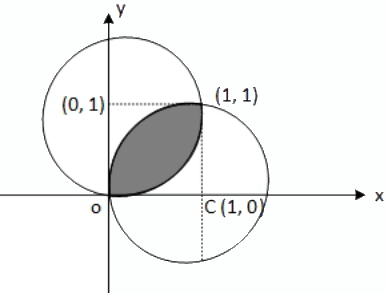

Q.64. If y = y(x) is the solution of the differential equation (dy/dx) + (tan x) y = sin x, 0 ≤ x ≤ (π/3), with y(0) = 0, then y(π/4) equal to : (JEE Main 2021)
(a) (1/2)(loge 2)
(b) (1/(2√2)) (loge 2)
(c) loge 2
(d) (1/4)loge2
Ans. b
Integrating Factor = e∫tanxdx = eln(secx) = sec x
y sec x = ∫(sin x) sec x dx = ln(sec x) + C
y(0) = 0 ⇒ C = 0
∴ y = cos x ln |sec x|
Q.65. If y = y(x) is the solution of the differential equation, (dy/dx) + 2ytanx = sinx, y(π/3) = 0, then the maximum value of the function y(x) over R is equal to: (JEE Main 2021)
(a) 1/8
(b) 8
(c) -(15/4)
(d) 1/2
Ans. a
(dy/dx) +2tanx.y = sinx
I.F. = e2ln(secx) = sec2x
y.sec2x = ∫ sin x sec2xdx = ∫ tan x sec x dx + c
ysec2x = sec x + c
y = cosx + ccos2x
x = π/3, y = 0
⇒ (1/2) + (c/4) ⇒ c = −2
∴ y = cosx − 2cos2x
∴ ymax = 1/8
Q.66. Let  be a differentiable function for all x ∈ R. Then f(x) equals : (JEE Main 2021)
be a differentiable function for all x ∈ R. Then f(x) equals : (JEE Main 2021)
(a) 
(b) 
(c) 
(d) 
Ans. c
Differentiating both sides w.r.t. x
f′(x) = ex.f(x) + ex (Using Newton L:eibnitz Theorem)
Integrating w.r.t. x
⇒ ln(f(x) + 1) = ex + c
Put x = 0
ln 2 = 1 + c (∵ f(0) = 1, from equation (1))
∴ ln(f(x) + 1) = ex + ln 2 − 1
Q.67. The rate of growth of bacteria in a culture is proportional to the number of bacteria present and the bacteria count is 1000 at initial time t = 0. The number of bacteria is increased by 20% in 2 hours. If the population of bacteria is 2000 after  hours, then
hours, then  is equal to : (JEE Main 2021)
is equal to : (JEE Main 2021)
(a) 16
(b) 8
(c) 2
(d) 4
Ans. d
(dx/dt) ∝ x
(dx/dt) = λx
ln x − ln 1000 = λt
ln(x/1000) = λt
Put t = 2, x = 1200
⇒ 2 = ek/2
⇒ ln 2 = (k/2)
⇒ (k/ln 2) = 2
⇒ (k/ln 2)2 = 4
Q.68. If a curve passes through the origin and the slope of the tangent to it at any point (x, y) is  then this curve also passes through the point : (JEE Main 2021)
then this curve also passes through the point : (JEE Main 2021)
(a) (4, 4)
(b) (5, 5)
(c) (5, 4)
(d) (4, 5)
Ans. b
Given
y (0) = 0
Solution of D.E.
Now, at x = 0, y = 0 ⇒ C = −2
∴ y = x (x − 2) − 4 − 2 (x − 2)
⇒ y = x2 − 4x
This curve passes through (5, 5)
Q.69. The population P = P(t) at time 't' of a certain species follows the differential equation (dP/dt) = 0.5P - 450. If P(0) = 850, then the time at which population becomes zero is : (JEE Main 2021)
(a) loge18
(b) (1/2)loge18
(c) 2loge18
(d) loge9
Ans. c
⇒ (t/2) = ln 18
⇒ t = 2 ln 18
Q.70. If y1/4 + y−1/4 = 2x, and  then |α − β| is equal to ______. (JEE Main 2021)
then |α − β| is equal to ______. (JEE Main 2021)
Ans. 17
⇒ (x2−1)y″ + xy′ − 16y = 0
So, |α − β| = 17
Q.71. If y = y(x), y ∈ [0, (π/2)) is the solution of the differential equation sec y(dy/dx) − sin(x+y)− sin(x − y) = 0, with y(0) = 0, then 5y′(π/2) is equal to _____. (JEE Main 2021)
Ans. 2
sec y(dy/dx) = 2sinxcosy
sec2ydy = 2sin x dx
tan y = −2cos x + c
c = 2
tan y = −2cosx + 2 ⇒ at x = π/2
tan y = 2
sec2y(dy/dx) = 2sinx
∴ 5(dy/dx) = 2
Q.72. Let F : [3, 5] → R be a twice differentiable function on (3, 5) such that  If
If  then α + β is equal to _______. (JEE Main 2021)
then α + β is equal to _______. (JEE Main 2021)
Ans. 16
F(3) = 0
y.(ex − 4) = ∫(3x2 + 2x)dx + c
y(ex − 4) = x3 + x2 + c
Put x = 3 ⇒ c = −36
Now, put value of x = 4 we will get α = 12 & β = 4
Q.73. Let y = y(x) be the solution of the differential equation dy = eαx + y dx; α ∈ N. If y(loge2) = loge2 and y(0) = loge(1/2), then the value of α is equal to _____. (JEE Main 2021)
Ans. 2
∫e−ydy = ∫eαxdx
Put (x, y) = (ln2, ln2)
Put (x, y) ≡ (0, −ln2) in (i)
(ii) − (iii)
⇒ α = 2 (as α ∈ N)
Q.74. Let y = y(x) be solution of the following differential equation  If y(0) = loge(α+βe−2), then 4(α+β) is equal to ____. (JEE Main 2021)
If y(0) = loge(α+βe−2), then 4(α+β) is equal to ____. (JEE Main 2021)
Ans. 4
Let ey = t
⇒ (dt/dx) - (2sin x)t = -sin xcos2x
I.F. = e2cos x
Put x = 0
Q.75. Let y = y(x) be the solution of the differential equation  If the domain of y = y(x) is an open interval (α, β), then |α + β| is equal to _______. (JEE Main 2021)
If the domain of y = y(x) is an open interval (α, β), then |α + β| is equal to _______. (JEE Main 2021)
Ans. 4
Let y + 1 = Y and x + 2 = X
dy = dY
dx = dX
∵ (1, 1) satisfy this equation
So, c = −e−(2/3)−ln 3
Now,
Domain :
So, α + β = −4
⇒ |α + β| = 4
Q.76. Let a curve y = y(x) be given by the solution of the differential equation  If it intersects y-axis at y = −1, and the intersection point of the curve with x-axis is (α, 0), then eα is equal to ______. (JEE Main 2021)
If it intersects y-axis at y = −1, and the intersection point of the curve with x-axis is (α, 0), then eα is equal to ______. (JEE Main 2021)
Ans. 2
2(1 − e−x)1/2 = √2(y + 1), passes through (α, 0)
Q.77. Let y = y(x) be the solution of the differential equation  with y(1) = 0. If the area bounded by the line x = 1, x = eπ, y = 0 and y = y(x) is αe2π + β, then the value of 10(α + β) is equal to ____. (JEE Main 2021)
with y(1) = 0. If the area bounded by the line x = 1, x = eπ, y = 0 and y = y(x) is αe2π + β, then the value of 10(α + β) is equal to ____. (JEE Main 2021)
Ans. 4
dividing both sides by x2, we get
Integrating both side, we get
Given, y(1) = 0 ⇒ at x = 1, y = 0
∴ ⇒sin−1(0) = ln(1)+C
⇒ C = 0
⇒ y = x sin(ln(x))
Let, lnx = t
⇒ x = et
⇒ dx = et dt
New lower limit, t = ln(1) = 0
and upper limit t = ln(eπ) = π
So, 10(α + β) = 4
Q.78. If y = y(x) is the solution of the equation  then
then
 is equal to ______. (JEE Main 2021)
is equal to ______. (JEE Main 2021)
Ans. 1
esin y cos y(dy/dx) + esin y cos x = cos x
Put esin y = t
I. F. = e∫cosxdx=esinx
Solution of differential equation :
t.esin x = ∫esin x.cos x dx
esin y.esin x = esin x+c
at x = 0, y = 0
1 = 1 + c ⇒ c = 0
∴ esin x + sin y = esin x
⇒ sin x + sin y = sin x
⇒ sin y = 0 ⇒ y = 0
= 1 + 0 + 0 + 0 = 1
Q.79. The difference between degree and order of a differential equation that represents the family of curves given by  is _____. (JEE Main 2021)
is _____. (JEE Main 2021)
Ans. 2
Differentiating both sides, we get
2yy′ = a
D = 3 & O = 1
∴ D − O = 3 − 1 = 2
Q.80. If the curve, y = y(x) represented by the solution of the differential equation (2xy2 − y)dx + xdy = 0, passes through the intersection of the lines, 2x − 3y = 1 and 3x + 2y = 8, then |y(1)| is equal to ___. (JEE Main 2021)
Ans. 1
Given,
(2xy2−y)dx + xdx = 0
1/y = z
I. F. = e∫(1/x)dx = x
∴ z(x) = ∫2(x)dx = x2 + c
⇒ (x/y) = x2 + c
As it passes through P(2, 1)
[Point of intersection of 2x − 3y = 1 and 3x + 2y = 8]
∴ (2/1) = 4 + c
⇒ c =-2
⇒ (x/y) = x2 - 2
Put x = 1
(1/y) = 1 - 2 = -1
⇒ y(1) = -1
⇒ |y(1)| = 1

